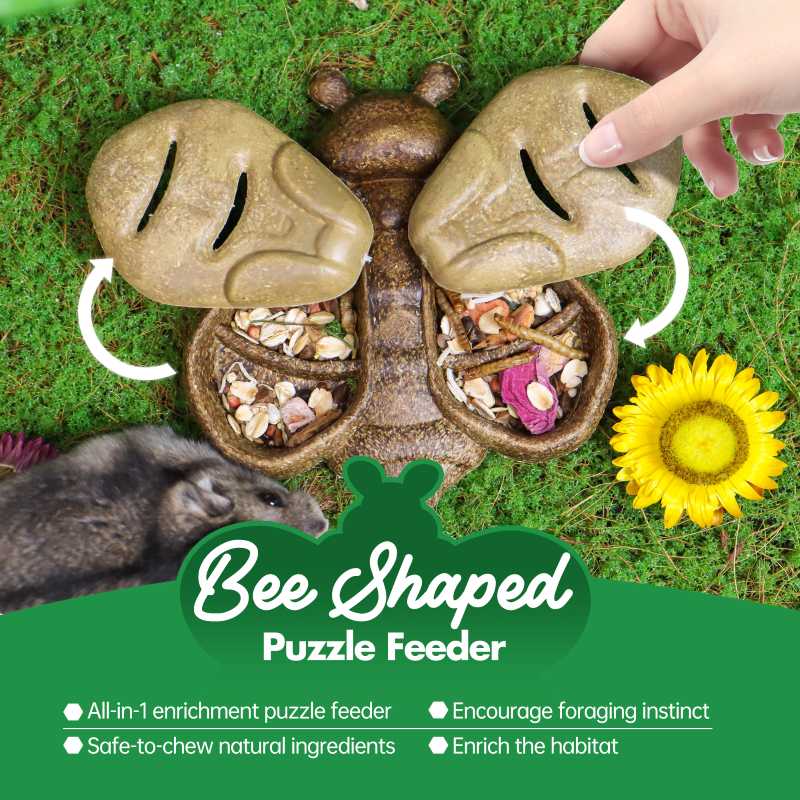Natural & Chewable Gerbil Feeders: Nurturing Instincts with Safe, Stimulating Solutions
Gerbils have quickly risen to the top of the small rodent pet list, loved for their playful energy, social nature, and charming personalities. To keep these little dynamos happy and healthy, it’s essential to understand their natural instincts—especially their strong need to forage and chew. A natural, chewable gerbil feeder isn’t just a food bowl, it’s a tool that supports their instinctive behaviors. Let’s explore why gerbils thrive with the right feeder, how to choose one, and our top recommendation for keeping them active and content.
Why Gerbils Are Among the Most Popular Small Rodents
Gerbils have earned their reputation as a favorite small pet for several reasons:
- Social & Friendly: Unlike some rodents, gerbils are highly social. They thrive in pairs or small groups, making them engaging companions for owners who enjoy watching their interactions.
- Active & Playful: These diurnal creatures (active during the day) fill their enclosures with zoomies, tunnels, and playful wrestling matches—offering endless entertainment.
- Low-Maintenance (With the Right Setup): Naturally clean and relatively odor-resistant, gerbils need less space than larger pets, making them perfect for apartments or first-time pet owners.
- Intelligent & Curious: Gerbils love problem-solving and exploring. They need mental stimulation just as much as physical care.
Their popularity comes from their ability to bond with owners while still expressing their natural, wild-born instincts—instincts that should be nurtured for them to truly thrive.
Instinctive Gerbil Behaviors Every Owner Should Know
To properly care for gerbils, it’s important to understand their natural instincts and behaviors:
- Foraging: In the wild, gerbils spend hours searching for seeds, grains, and insects. This isn’t just about food—it’s essential mental stimulation that keeps their brains active and sharp.
- Chewing: Gerbils’ teeth grow continuously (up to 5 inches per year!). Chewing is vital to wear them down and prevent overgrowth, which can cause pain and eating difficulties.
- Burrowing & Tunneling: Gerbils are natural diggers, building complex underground nests. This behavior reduces stress and fulfills their need for safety and security.
- Food Storing: Gerbils instinctively hoard food, hiding it in cheek pouches or burrows. This helps them feel prepared and in control of their environment.
When these behaviors are ignored, gerbils may develop boredom, stress, or destructive habits such as chewing cage bars. The solution? Provide tools and enrichment that let them express their natural instincts.
How to Support Your Gerbil’s Foraging Instinct
Foraging is more than getting food—it’s essential for your gerbil’s mental health. Without it, gerbils may become lethargic, over-groom, or even display aggression. Here are some simple ways to encourage natural foraging:
- Scatter Feeding: Instead of placing food in a bowl, scatter seeds or pellets around the enclosure, in tunnels, or under bedding. This mimics the challenge of searching for food in the wild.
- Foraging Toys: Offer puzzle feeders or chewable bowls that require effort to access food, turning mealtime into an engaging activity.
- Rotate Enrichment: Change where and how you present food weekly to keep the environment stimulating and unpredictable.
A well-designed feeder transforms mealtime into a mental workout, keeping your gerbil both occupied and stimulated.
How to Choose the Right Gerbil Feeder (Food Bowl)
Not all feeders are created equal for gerbils. The best options should meet the following criteria:
100% Safe, Natural Materials: Avoid plastic (gerbils will chew it, risking choking or intestinal blockages) and treated wood (which may contain toxic chemicals). Choose edible, plant-based materials such as wheat straw, natural wood, or hay.
Chewable by Design: The feeder should double as a chew toy, allowing gerbils to wear down their teeth while eating.
Easy Access, but Not Too Easy: A good feeder requires a bit of effort—nibbling or nudging—to release food. This satisfies their natural foraging instincts without causing frustration.
Size-Appropriate: The feeder should be small enough for gerbils to handle, yet sturdy enough to withstand constant chewing. Avoid deep bowls that make food difficult to reach.
Easy to Clean: Simple designs or removable parts help prevent mold from leftover food (critical for health!).
Common Gerbil Feeder Types on the Market
Not sure which feeder to choose? Here’s a breakdown of the most common types, with their pros and cons:
Plastic Bowls: Cheap and widely available, but unsafe—gerbils will chew the plastic, which can splinter and cause injuries. Best avoided.
Ceramic Bowls: Heavy and chew-proof, so they won’t tip over. However, they don’t satisfy chewing needs and make feeding too passive, offering no foraging stimulation.
Wooden Feeders: Natural and chewable, but some may contain glue or treated wood that is toxic. Always select unprocessed, edible wood options.
Foraging Toys with Built-in Feeders: These combine feeding with play—for example, balls that release seeds when rolled, or puzzle toys that require nibbling to open. Excellent for mental stimulation, but quality can vary depending on the product.
Pet Union’s Bee-Shaped Foraging Feeder: A Natural, Chewable Solution
For gerbil owners seeking a feeder that checks all the boxes, we recommend our Bee-Shaped Feeder & Edible Food Bowl. Designed specifically for small rodents like gerbils, this feeder is a game-changer for instinct-driven care:

Key Features:
- 100% Natural & Edible Materials: Crafted from wheat straw, corn fiber, Timothy grass, and other edible plants—safe for chewing, nibbling, and even ingesting with fiber benefits.
- Foraging Fun: The bee’s wings feature separated holes that can be filled with small treats, pellets, or fresh veggies. Gerbils must rotate, nibble, and explore to access their food, mimicking natural foraging behavior.
- Dual Purpose: Functions as both a feeder and a chew toy, helping keep teeth naturally trimmed while reducing boredom.
- Perfect Size: Compact for gerbil paws to grip and manipulate, with a stable base that resists tipping.
- Eco-Friendly: Biodegradable and sustainably sourced, supporting the growing demand for green, natural pet products.
This feeder turns every meal into an adventure—supporting both foraging and chewing instincts while keeping gerbils safe, healthy, and satisfied.
Other Essentials for a Gerbil Enclosure
A feeder is just one part of a gerbil’s well-balanced environment. To ensure they thrive, consider these essentials:
Burrowing Bedding: Provide dust-free paper bedding, aspen shavings, or hay to allow tunneling and nesting. Avoid cedar or pine due to harmful oils.
Chew Toys: Offer a variety of textures such as apple or willow sticks, hay cubes, or loofah toys for extra chewing outlets.
Hiding Spots: Small houses, wooden huts, or ceramic caves give gerbils a safe retreat, reducing stress.
Water Bottle: Use a chew-resistant sipper bottle to keep water clean and prevent spills—bowls are not recommended.
Exercise Wheel: A solid-surface wheel (without rungs) provides a safe way for gerbils to burn energy.
In Summary: Feed Their Instincts, Feed Their Happiness
Gerbils aren’t just “cute pets”—they’re lively little creatures with needs deeply connected to their natural instincts. A safe and chewable feeder like our Bee-Shaped Foraging Feeder does more than hold food, it encourages foraging and chewing behaviors, helping gerbils stay mentally engaged, physically healthy, and happily entertained.
By choosing products that respect their wild nature, you’ll create a thriving environment where your gerbil can truly flourish. For more small pet care tips, or to explore our range of gerbil-safe products, visit Pet Union’s Small Animal Collection today!
